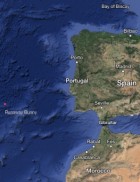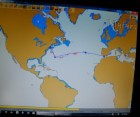Voyage East from Rhode Island
Crossing the Atlantic Ocean on Runaway Bunny
| Vessel Name: | Runaway Bunny |
| Vessel Make/Model: | Sloop |
| Crew: | Crew: Eran, Rob, Joy, Charlie, Tristan, Juan. |
| About: | Captain: Eran Gindi |
16 November 2013 | Mallorca
13 November 2013 | Atlantic Ocean
06 November 2013 | 37deg42.4N 16deg16.2W
02 November 2013 | Azores
02 November 2013
31 October 2013
30 October 2013
27 October 2013 | 35º42.932n 49º02.522w
26 October 2013 | Atlantic Ocean
26 October 2013
26 October 2013
26 October 2013 | North Atlantic
24 October 2013 | North Atlantic
24 October 2013 | North Atlantic
23 October 2013
23 October 2013
22 October 2013 | Bermuda
20 October 2013 | Bermuda
19 October 2013 | North Atlantic
19 October 2013
Recent Blog Posts
Atlantic Winds
19 October 2013 | North Atlantic

Atlantic winds
The North Atlantic Oscillation (NAO) is a climatic phenomenon in the North Atlantic Ocean of fluctuations in the difference of atmospheric pressure at sea level between the Icelandic low and the Azores high.
Through east-west oscillation motions of the Icelandic low and the Azores high, it controls the strength and direction of westerly winds and storm tracks across the North Atlantic.
Westerly winds blowing across the Atlantic bring moist air into Europe. In years when westerlies are strong, summers are cool, winters are mild and rain is frequent. If westerlies are suppressed, the temperature is more extreme in summer and winter, leading to heat waves, deep freezes and reduced rainfall.
Especially during the months of November to April, the NAO is responsible for much of the variability of weather in the North Atlantic region, affecting wind speed and wind direction changes, changes in temperature and moisture distribution and the intensity, number and track of storms.
The North Atlantic Oscillation (NAO) is a climatic phenomenon in the North Atlantic Ocean of fluctuations in the difference of atmospheric pressure at sea level between the Icelandic low and the Azores high.
Through east-west oscillation motions of the Icelandic low and the Azores high, it controls the strength and direction of westerly winds and storm tracks across the North Atlantic.
Westerly winds blowing across the Atlantic bring moist air into Europe. In years when westerlies are strong, summers are cool, winters are mild and rain is frequent. If westerlies are suppressed, the temperature is more extreme in summer and winter, leading to heat waves, deep freezes and reduced rainfall.
Especially during the months of November to April, the NAO is responsible for much of the variability of weather in the North Atlantic region, affecting wind speed and wind direction changes, changes in temperature and moisture distribution and the intensity, number and track of storms.
Comments
Gallery not available




